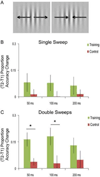Neural plasticity underlying visual perceptual learning in aging
- PMID: 25218557
- PMCID: PMC4362864
- DOI: 10.1016/j.brainres.2014.09.009
Neural plasticity underlying visual perceptual learning in aging
Abstract
Healthy aging is associated with a decline in basic perceptual abilities, as well as higher-level cognitive functions such as working memory. In a recent perceptual training study using moving sweeps of Gabor stimuli, Berry et al. (2010) observed that older adults significantly improved discrimination abilities on the most challenging perceptual tasks that presented paired sweeps at rapid rates of 5 and 10 Hz. Berry et al. further showed that this perceptual training engendered transfer-of-benefit to an untrained working memory task. Here, we investigated the neural underpinnings of the improvements in these perceptual tasks, as assessed by event-related potential (ERP) recordings. Early visual ERP components time-locked to stimulus onset were compared pre- and post-training, as well as relative to a no-contact control group. The visual N1 and N2 components were significantly enhanced after training, and the N1 change correlated with improvements in perceptual discrimination on the task. Further, the change observed for the N1 and N2 was associated with the rapidity of the perceptual challenge; the visual N1 (120-150 ms) was enhanced post-training for 10 Hz sweep pairs, while the N2 (240-280 ms) was enhanced for the 5 Hz sweep pairs. We speculate that these observed post-training neural enhancements reflect improvements by older adults in the allocation of attention that is required to accurately dissociate perceptually overlapping stimuli when presented in rapid sequence. This article is part of a Special Issue entitled SI: Memory Å.
Keywords: Aging; Cognitive training; ERP; Perceptual learning; Transfer of benefit; Visual perception; Working memory.
Copyright © 2014 Elsevier B.V. All rights reserved.
Figures



Similar articles
-
Task difficulty modulates electrophysiological correlates of perceptual learning.Int J Psychophysiol. 2010 Mar;75(3):234-40. doi: 10.1016/j.ijpsycho.2009.11.006. Epub 2009 Dec 4. Int J Psychophysiol. 2010. PMID: 19969030
-
Working memory training impacts neural activity during untrained cognitive tasks in people with multiple sclerosis.Exp Neurol. 2021 Jan;335:113487. doi: 10.1016/j.expneurol.2020.113487. Epub 2020 Sep 28. Exp Neurol. 2021. PMID: 32991935
-
Working memory training and perceptual discrimination training impact overlapping and distinct neurocognitive processes: Evidence from event-related potentials and transfer of training gains.Cognition. 2019 Jan;182:50-72. doi: 10.1016/j.cognition.2018.08.012. Epub 2018 Sep 12. Cognition. 2019. PMID: 30218913
-
Visual Perceptual Learning and Models.Annu Rev Vis Sci. 2017 Sep 15;3:343-363. doi: 10.1146/annurev-vision-102016-061249. Epub 2017 Jul 19. Annu Rev Vis Sci. 2017. PMID: 28723311 Free PMC article. Review.
-
Perceptual learning in Vision Research.Vision Res. 2011 Jul 1;51(13):1552-66. doi: 10.1016/j.visres.2010.10.019. Epub 2010 Oct 23. Vision Res. 2011. PMID: 20974167 Review.
Cited by
-
Visual Perceptual Learning of Form-Motion Integration: Exploring the Involved Mechanisms with Transfer Effects and the Equivalent Noise Approach.Brain Sci. 2024 Sep 30;14(10):997. doi: 10.3390/brainsci14100997. Brain Sci. 2024. PMID: 39452011 Free PMC article.
-
Visual motion perception improvements following direct current stimulation over V5 are dependent on initial performance.Exp Brain Res. 2020 Oct;238(10):2409-2416. doi: 10.1007/s00221-020-05842-7. Epub 2020 Aug 9. Exp Brain Res. 2020. PMID: 32776173 Clinical Trial.
-
Dissociable neural mechanisms of cognition and well-being in youth versus healthy aging.Psychol Aging. 2022 Nov;37(7):827-842. doi: 10.1037/pag0000710. Epub 2022 Sep 15. Psychol Aging. 2022. PMID: 36107693 Free PMC article.
-
Age-related declines of stability in visual perceptual learning.Curr Biol. 2014 Dec 15;24(24):2926-9. doi: 10.1016/j.cub.2014.10.041. Epub 2014 Nov 26. Curr Biol. 2014. PMID: 25454783 Free PMC article.
-
Case report: Neural timing deficits prevalent in developmental disorders, aging, and concussions remediated rapidly by movement discrimination exercises.Front Neurol. 2023 Sep 25;14:898781. doi: 10.3389/fneur.2023.898781. eCollection 2023. Front Neurol. 2023. PMID: 37818220 Free PMC article.
References
Publication types
MeSH terms
Grants and funding
LinkOut - more resources
Full Text Sources
Other Literature Sources
Medical

